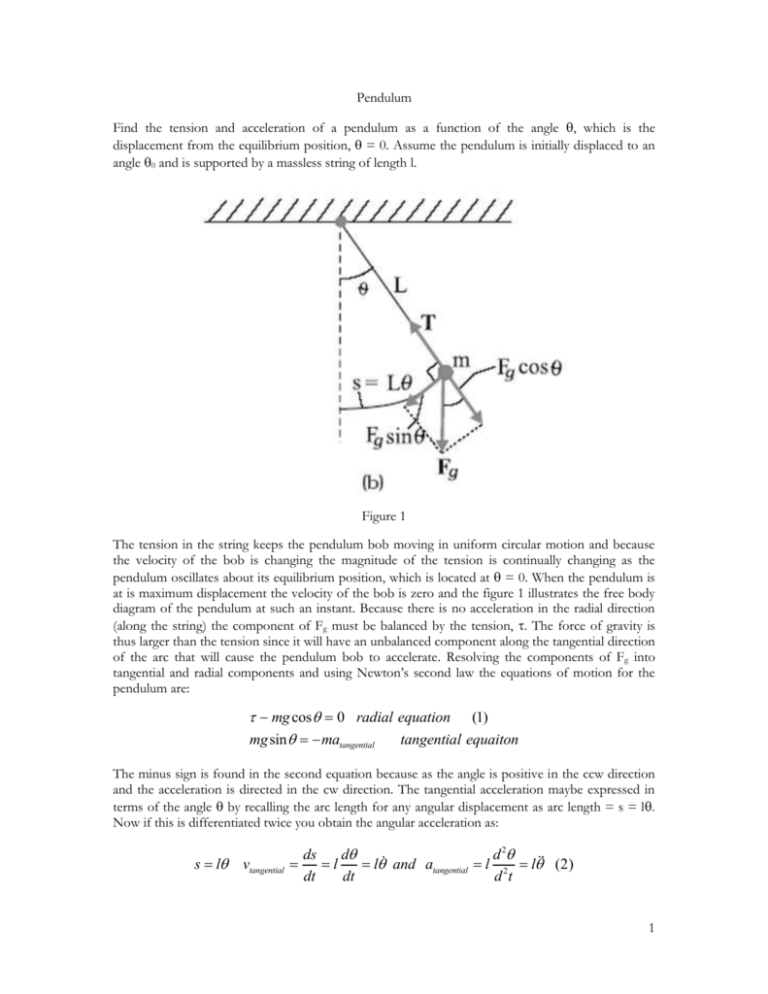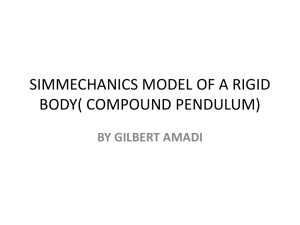Pedulum Example
advertisement

Pendulum Find the tension and acceleration of a pendulum as a function of the angle , which is the displacement from the equilibrium position, = 0. Assume the pendulum is initially displaced to an angle 0 and is supported by a massless string of length l. Figure 1 The tension in the string keeps the pendulum bob moving in uniform circular motion and because the velocity of the bob is changing the magnitude of the tension is continually changing as the pendulum oscillates about its equilibrium position, which is located at = 0. When the pendulum is at is maximum displacement the velocity of the bob is zero and the figure 1 illustrates the free body diagram of the pendulum at such an instant. Because there is no acceleration in the radial direction (along the string) the component of Fg must be balanced by the tension, . The force of gravity is thus larger than the tension since it will have an unbalanced component along the tangential direction of the arc that will cause the pendulum bob to accelerate. Resolving the components of Fg into tangential and radial components and using Newton’s second law the equations of motion for the pendulum are: mg cos 0 radial equation (1) mgsin matangential tangential equaiton The minus sign is found in the second equation because as the angle is positive in the ccw direction and the acceleration is directed in the cw direction. The tangential acceleration maybe expressed in terms of the angle by recalling the arc length for any angular displacement as arc length = s = l. Now if this is differentiated twice you obtain the angular acceleration as: s l vtangential ds d d 2 l l and atangential l 2 l (2) dt dt dt 1 If the tangential equation is inserted into the second equation of (1) the equation of motion along the tangent are may be written as: ml d 2 mgsin 0 or (3) dt 2 d 2 g 0 dt 2 l In the last expression the small angle approximation has been used. Recall that when the angle is expressed in radians sin , tan , and cos 1. These are the so called small angle approximations and occur frequently in the analysis of problems; specifically they are used to linearize a problem, which means make it simpler to solve by casting the problem in linear form. Whenever you see a problem whose equation of motion may be expressed as an acceleration plus a constant times the displacement you should immediately think of the simple harmonic oscillator equation, which is: m d2x d2x k kx 0 or x0 dt 2 dt 2 m d2x 2x 0 2 dt (4) Equations (3) and (4) are identical in form and therefore their solutions will be identical in form. Recall that was defined as the angular frequency for SHO (simple harmonic oscillator), therefore the quantity g/l is the angular frequency squared, in the case of the pendulum. By analogy with the SHO it should be evident that the angle varies sinusoidally in time and has the general solution; (t) A cos( t) Bsin( t) (5) Figure 2 2 So , the displacement of the pendulum exhibits SHO provided that displacement from equilibrium is small and the small angle approximation may be employed. As we shall see later the period of a pendulum, unlike a SHO, is not independent on the amplitude of oscillation. Indeed one of the characteristics of SHO is that the period of oscillation is independent of the amplitude of oscillation. Returning to the problem of finding the tension in the string as a function of we know the tension must always be sufficiently large to balance the radial force that arises due to gravity; however, if the pendulum is in motion it will have a velocity, v() and this velocity will create a centripetal acceleration and corresponding centripetal force that will add to the tension in the string. Thus the total tension in the string is composed of two terms; the Fg cos part and the centripetal term that depends on v(). The tension as a function of may be written as: mv 2 ( ) mv 2 ( ) ( ) Fg cos mg cos l l (6) In order to find the tangential velocity as a function of the angle, , recall that the forces involved are conservative and thus the total energy of the system is conserved. Therefore when the pendulum is at its extreme displacement 0 the pendulum’s potential energy will be all potential since the tangential velocity is zero at these points. From figure 2 it is clear that h = y1 – y0 and that the potential energy of the pendulum is U = mgh = mg(y1 – y0). But y1 is just the length of the pendulum and y0 is equal to y1 cos so that the potential energy at the maximum angle is, which is also the total energy is: U( ) mgl(1 cos ) ETotal U( 0 ) mgl(1 cos 0 ) (7) Now using conservation of total energy it follows that T, the kinetic energy, plus U() the potential energy at arbitrary must equal ETotal at all times or: ETotal mgl(1 cos 0 ) T U( ) (8) 1 2 mv mgl(1 cos ) 2 v 2 ( ) 2gl(cos cos 0 ) mgl(1 cos 0 ) a aT aR g sin e 2g(cos cos 0 )er (10) a a a g sin 2 4(cos cos 0 )2 g 1 3cos 2 4 cos2 0 8 cos cos 0 (11) In the last line of equation 8 the velocity has been explicitly written to show that the velocity is a function of the angle . Now substituting this expression into equation (6) the tension may be written as: ( ) mg cos 2mg(cos cos 0 ) 3mg cos 2mg cos 0 (9) Does the answer make sense? It is always a good idea to check limiting cases. For example when = 0 the answer reduces to (0)=mgcos0, which is correct. The case that is a bit more difficult to see is the case when = 0 for which (0) = 3mg - 2mgcos0. At first glance you may think this is 3 incorrect because the tension for the pendulum when hanging is just mg. This would be the answer if the pendulum were stationary and had no velocity, so that 0 = 0 and then the answer reduces to the expected result, however since it does have a velocity that depends on the angle 0 the answer is in general greater than mg. Figure 3 - Pendulum Tension (Magnitude) as a Function of Angle The red trace is the tension in the string as the pendulum swings back and forth, the blue line is the tension in the string if the pendulum was hanging in its equilibrium position, and the green trace is the tension at the maximum angular displacement when the tangential velocity has dropped to zero. The acceleration has two components; a radial component that always points along the string and a tangential component that points along the tangent toward the equilibrium. Since the acceleration is a vector it would be nice to express the components as a function of the angle . The tangential component of the acceleration is just gsin, which we can see from equation 1 for the restoring force mgsin. The component of force along the string is just the centripetal acceleration, which we can obtain from the expression for v(), which is equation 8. Thus the acceleration is: a aT aR g sin e 2g(cos cos 0 )er (10) The tangent unit vector has been defined as positive when pointing toward the equilibrium and the radial unit vector has been defined as positive when pointing toward the pivot point. The magnitude of the acceleration is: a a a g sin2 4(cos cos0 )2 g 1 3cos2 4 cos2 0 8cos cos0 (11) Does this result make sense? Suppose is zero and 0 are both zero then the acceleration of the bob is zero and this is an expected result. Notice that the acceleration of the bob is primarily caused by the unbalanced component of g but is however modified by the centripetal component of acceleration that acts along the line from the bob to the pivot point. For example at = 2.4 degrees the components are equal so the acceleration will have a direction in the fourth quadrant pointing NW. Test other points and note that the acceleration is tangent to the arc for the maximum angular displacement and is purely radial at = 0. As the pendulum moves from its maximum displacement the direction of the acceleration is initially along the tangent to the arc and as the pendulum 4 approaches equilibrium the direction of the acceleration rotates cw until it is in the radial direction at the equilibrium position. (Remember how the unit vectors were defined above.) Figure 4 – Magnitude and components of acceleration Pendulum Problem A pendulum is displaced from equilibrium by a string that is pulled horizontally until the pendulum has been displaced through an angle 0. Compute the work done by the horizontal force as the pendulum moves form = 0 to = 0. Repeat by now assume the force is applied along a tangent line to the arc through which the pendulum is displaced. 5








